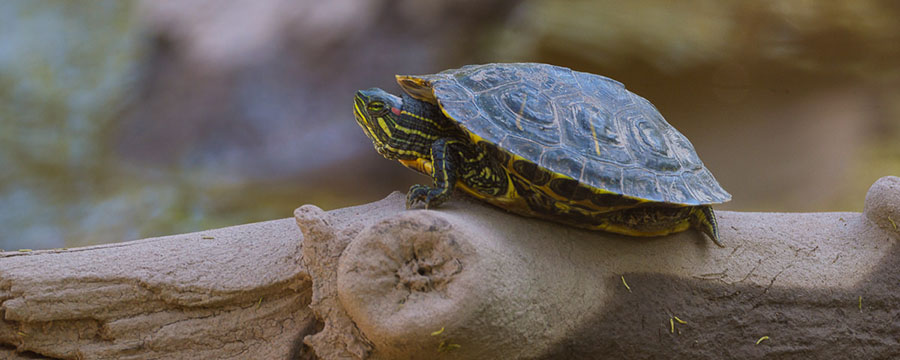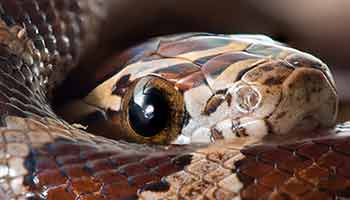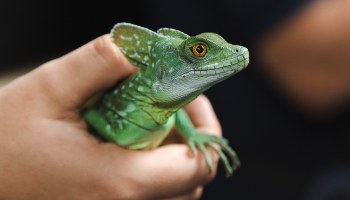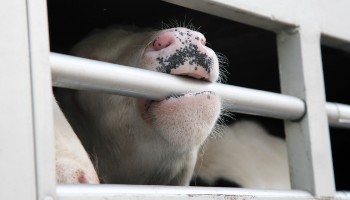Terrapins' needs are complex. They require lots of care and equipment to keep them healthy for life – which can be as long as 30 or 40 years. Terrapin ownership isn't something to be undertaken on a whim.
The biology of captive terrapins is the same as those living in the wild, so you should meet your pet's needs by mimicking their natural environment as much as possible.
Biology
Pond terrapins are found across the southern states of North America. They're semi-aquatic and bask on land, rocks or floating branches throughout the day.
This species is diurnal, meaning they're active during the day. They slide into the water if predators approach, which is why they’re also called sliders. In the wild, they have a varied diet of fish, amphibians, rodents, birds, eggs and many different plants.
Terrapins have been reported living around 30 to 40 years in captivity. Hatchling sliders tend to grow very quickly; small babies will rapidly grow to be as big as a dinner plate.
They're active and inquisitive animals who require a high level of care.
Environment
Terrapins should be housed in large tanks, at least when young. You can house them in secure outdoor ponds with outdoor heating and lighting when adult. In any case, the enclosure must be secure to prevent escape and free from hazards that might cause injuries, including other pets or children.
Fish tanks are ideal and easy to keep clean. Another option is a specially made terrapin tub. This is a large plastic tub with space for both water and a dry area.
As a minimum, terrapins need enough water to be able to swim without touching the sides or bottom of the tank, or breaking the surface of the water. Larger volumes of water are easier to keep clean. A good sized tank allows 80 litres of water per 5cm of shell length. Therefore, a terrapin with a 25cm long shell will need 400 litres of water.
It’s cost effective to get an enclosure large enough for the adult at the outset, then increase the water level as your terrapin grows. You’ll need a cover that does not hold in humidity, such as wire mesh, as good ventilation is essential to reduce the risk of health problems.
Temperature
Reptiles are ectothermic, meaning they use their environment to warm up and cool down. A core aspect of reptile keeping is maintaining a thermogradient. This involves creating a basking zone, where the animal can absorb warmth, while leaving another area cool to allow the terrapin to choose the level of heat they need.
To make a basking zone, use a reptile heat lamp pointing downwards to create an area of heat large enough to warm up the whole body, and not just the shell. You’ll need to provide a dry area under the heat lamp that is big enough to support the animal and a ramp for access to it from the water, then add another dry platform in a cooler area of the tank.
All heat sources must have a guard around them to prevent injury to the terrapin, and be controlled by a thermostat. Place the probe of a thermostat at the level where the animal can reach. Adjust the thermostat and check the temperature with a digital thermometer until the basking zone reads 30–35°C.
Thermostats are not always accurate, so you must check the temperatures at least once a day. Use a digital thermometer or infrared thermometer under the basking zone and another in the cool area. In a warm household, you can turn off the basking lamp at night to simulate night-time.
For the water, use an aquarium heater with a guard and an inbuilt thermostat, set to about 25°C for hatchlings, decreasing to 22°C for adults. Check this temperature daily using a waterproof thermometer. The tank should be placed in a safe location away from draughts and sources of heat (such as direct sunlight or radiators) as these can affect the temperature.
It’s also important to give the terrapins privacy – these are secretive animals who need lots of cover. They’ll then feel more comfortable and will come out of hiding over time.
Light
Reptiles use natural daylight to set their day and night patterns. Sunlight contains visible light and ultraviolet light (UV). One part of UV is called UVB, which allows reptiles to make vitamin D3, vital for them to store and use calcium. Another part is UVA, which is important for them to see their world in full colour.
Create a photogradient, from light to shade, by grouping your light with the heat source so the cool end is more shaded, just as in the wild. Fit a 7–12 percent UVB reptile lamp over two-thirds of the tank to create a wide area of UV. UVB decreases with distance, so follow the UVB lamp manufacturer’s recommendations on the distance between the lamp and the terrapin’s shell. Use the correct length reflector to direct the light downwards.
The UVB output decreases over time so you should check the UVB output regularly, using an appropriate UV Index (UVI) meter positioned at the level of the animal directed towards the UV lamp. Pond terrapins need a gradient of UVB within their enclosure ranging from UVI 3.0-5.0 in the basking zone to zero in the shade. The lamp must also be replaced according to the manufacturer’s instructions.
As with heat lamps, UV lamps must always be guarded to prevent burns, or injuries should the bulb shatter.
Turn off all lights at night. You can use a simple plug-in timer: set it for 12 hours on during the day and 12 hours off at night.
Cleaning
Terrapins need constant access to clean water to swim in. The water will need powerful filtration and regular maintenance – sliders produce lots of waste. A well set-up filter allows beneficial bacteria to grow, which break down waste naturally.
You need to carry out weekly 20 percent water changes to dilute the waste products that your filter can’t break down. It’s vital that the filter sponge is swished in the tank water before you throw it away, because this clears the filter sponge of solids but keeps the helpful bacteria. For the health of the terrapin and your filter, you will need to add a dechlorinating product when you replace the water.
You’ll also need to ensure that the water is low in wastes called ammonia and nitrite – purchase testing kits for these and check the water quality often. If your tests show that the waste levels are high, you’ll need to change half of the water every day and keep testing until conditions improve. If the waste doesn’t decrease over time then you probably need a stronger filter.
The main cause of poor water quality is over-feeding because uneaten food is left to rot. A UVC steriliser is also a good idea as it will kill off harmful bugs in the water.
Be careful as reptiles can carry salmonella. Wash your hands before and after handling the slider or the equipment, to reduce the spread of infection between you and the terrapin.
Diet
Feeding
Terrapins need a varied diet. Do lots of research and discuss different diets with your reptile vet.
A quality dried terrapin food should be used alongside thoroughly defrosted freshwater fish; make sure the fish is completely thawed and at room temperature, otherwise it can make your reptile very ill. Sliders shouldn’t be kept with live fish because they will kill or chase the fish, causing them stress.
Terrapins will also eat live plants – make sure that the plants that you offer are safe, such as pond weed – and live invertebrate foods including river shrimps, blood worms and locusts.
Feed your slider every two days and only offer as much as they can eat in five minutes, then use a net to remove uneaten food from the water. Terrapins are opportunistic feeders and will overfeed if allowed to, which can cause obesity or too rapid growth which can cause disease. It’s a good idea to weigh them regularly to keep an eye on this.
Supplements provide the vitamins and minerals that aren’t available in captivity – lightly sprinkle them onto the food source before feeding. Speak to your reptile vet about the best supplements to use. It’s possible to over-provide supplements so always follow the manufacturer’s instructions. For example, with a well-set UV system you won’t need to provide high dietary vitamin D3 levels.
You should also provide natural cuttlefish bone pieces for the slider to chomp on as a source of calcium.
Behaviour
Enrichment
Providing opportunities for natural behaviour is known as enrichment. Research shows that reptiles can learn simple tasks and they’re more complex than people thought in the past.
You’ll have already created areas for basking and swimming, but you can also add securely placed rocks in the water for the slider to investigate and hide between. You can also provide enrichment by feeding live river shrimp which the slider can hunt in the water.
You should also add plants such as pond weed in the water, which will increase the dissolved oxygen and can be eaten by the slider. Floating plants will make the slider feel more secure and provide shade too.
Substrate
Substrate is the name for the covering on the tank floor, and is recommended in a glass aquarium so that the terrapin can’t shred the sealant. Fine sand can be used but avoid small stones or gravel as they're sometimes eaten, causing a blockage in the digestive tract.
Clean the sand substrate regularly when you do your water changes, with the use of a syphon. A thin layer is easier to keep clean as waste stuck in the sand will break down slowly and add toxins into the water. In the dry area you can use an organic soil/sand mix.
Owners should also consider a bioactive system. There are expert books on the topic, and specialist keeper groups online.
Bringing your terrapin home
Always set up the tank two weeks before introducing your terrapin to ensure the electrics are running correctly. The water will come to temperature and the filter will start to cycle during this time.
Place the container with the terrapin inside onto the basking platform and gently allow the terrapin to come out. Secure the tank and leave the lights off until the following day, to reduce stress and allow the slider to explore. Turn your lights on again the next morning and check on your terrapin.
Company
If you want to keep more than one terrapin, you’ll need to provide a basking spot for each animal and make sure they’re all getting enough food. Terrapins can become aggressive to one another, especially if they feel overcrowded as they will fight for resources.
Handling
Terrapins should not be petted, especially when young as they're quite fragile. However, you can get them used to some handling to make health checks, transport and cleaning easier and less stressful for them.
Gently pick up the terrapin at either side of the shell, so that they can’t reach around and bite you. Always wash your hands well before and after handling your terrapin.
Health
Shedding
Terrapins are reptiles, who shed their skin. Shell plates will shed individually and the skin around the legs and neck will shed in pieces. Both should happen easily without intervention.
Having the opportunity to come out of the water often is important for shedding, otherwise they can get fungal infections. If your terrapin has sores or is constantly shedding, you should seek the advice of your reptile vet to rule out a shell or skin infection.
Diseases and concerns
A healthy terrapin has clear, bright eyes and a smooth shell. The skin should be smooth and without blisters, which can be a sign of an infection.
You should register with a suitably qualified reptile vet so that the animal can have access to check-ups and medical treatment as necessary. Sliders can suffer from nutritional diseases, unless they have a varied and well-planned diet and the heating and lighting systems are tested to be working well at all times.
It’s important to feed a range of fish, so that the terrapin gets a varied diet and also to avoid a build up of toxins from any one type of fish.
One of the most common and serious issues that affects captive reptiles is vitamin or mineral deficiencies. Metabolic bone disease (MBD) describes a range of nutritional diseases and imbalances, typically involving a lack of available calcium due to a deficiency of vitamin D3, most often due to a lack of UVB lighting. Symptoms of MBD include swellings around the mouth or eyes, or the shell becoming uneven. Young turtles with MBD can have soft shells, like rubber.
Terrapins are also very susceptible to eye problems. This may be related to water quality or due to vitamin A deficiency, which is one of the reasons why a varied diet is so important. Try to include lots of vegetables containing beta carotene, such as sweet potato.
If the terrapin is not eating as normal then this may be a sign of internal parasites. Sliders can also suffer with mouth infection or mouth rot, so look out for changes in the mouth.
Terrapins are a large species that require lots of care and equipment to keep them happy and healthy for life. It’s essential that you take time to research the diseases of pond terrapins further. If you do get a terrapin, monitor its health daily and contact your reptile vet urgently if you have any concerns.
Transport
If you need to transport your terrapin, for example to the vets, it’s important to do so safely. Choose a suitable sized carrier for the size of terrapin and make sure it's secure so they can't escape.
Use a top-ventilated container with some paper towels, kept damp. If the transport time is short, use a dry towel to prevent them getting too cool. Keep this warm; you may need to add a heat pack but make sure it won’t overheat. Keep transport and packaged time to a minimum to reduce stress.




